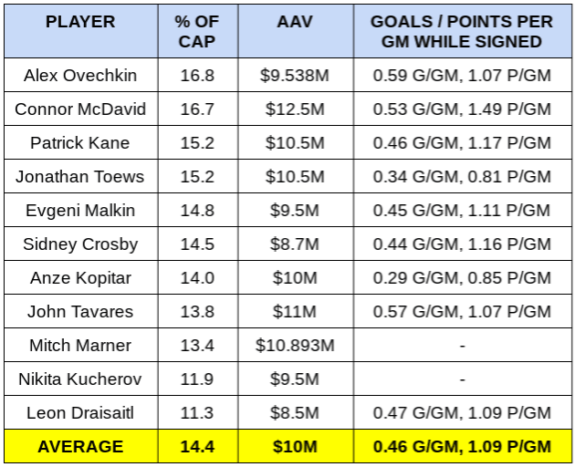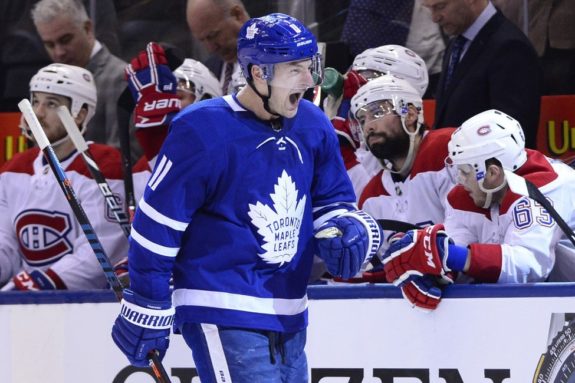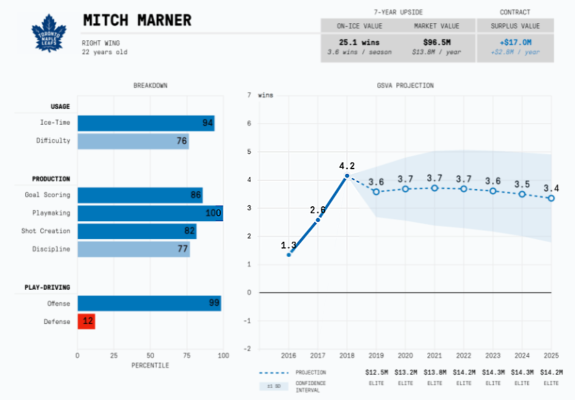The summer of Mitch Marner has finally come to an end with the Toronto Maple Leafs star winger signing for six years at an average annual value (AAV) of $10.893 million. This new deal makes Marner the second-highest paid winger in the NHL after Artemi Panarin and the seventh-highest paid player overall.

Almost unanimously, the popular opinion is that Marner was overpaid. If you’re looking at historical cap comparables, then it certainly looks like the Maple Leafs gave the hometown boy about $2 million more than he’s worth. But that’s neither here nor there. What’s done is done, and it’s time to move on. Marner got his money; the Maple Leafs got their player locked up long-term.
Now we look to the future. What must Marner do to live up to his shiny new contract?
He Needs to Score – a Lot
When it comes down to it, the only way for Marner to live up to his $10.893 million cap hit will be by collecting points. And a lot of them. If we look around the league at cap comparables, we can roughly figure out how much Marner must score for his play to be equal to his pay.
Most people like to talk in terms of raw dollars when comparing player contracts, but in earnest, cap percentages are a much more accurate way of looking at things given the NHL’s ever-changing salary cap. Going back just five years, the league’s cap has grown by $12.5 million. Alex Ovechkin, for instance, signed his 12-year, $124-million contract in 2008, back when the salary cap was just $50.3 million – and back when 12-year contracts were still allowed by the league’s collective bargaining agreement. This is why despite his AAV of just $9.538 million, Ovechkin actually has the highest cap hit percentage in the NHL at 16.8 percent.

Marner, signing in 2019 with a league salary cap of $81.5 million, carries a higher AAV than Ovechkin, yet his cap hit percentage falls well below the Russian’s at 13.4 percent – good for 14th-highest in the league.
That said, here’s a look at where the newly paid Maple Leaf and his contract place relative to some comparables around the league.

Kucherov and Draisaitl clearly aren’t in the same ballpark as Marner when it comes to percentage of the cap, but I threw them in there for the sake of the exercise. While his $9.5 million AAV won’t kick in until this coming season, Kucherov has scored 1.33 points per game and 0.51 goals per game over the last three seasons. The Tampa Bay Lightning star is widely considered the modern “benchmark” for wingers today, so for Marner to make more than him is a big deal (literally and figuratively). And it helps to illustrate the kinds of lofty expectations that now fall on the 22-year-old’s shoulders.
Beyond that, look at the average numbers at the bottom. Based on the players listed, excluding Marner, the average top-paid forward will take up 14.4 percent of his team’s cap, earn $10 million per season, and score 0.46 goals per game and 1.09 points per game. That translates to 38 goals and 89 points over an 82 game season.
Given that the average cap hit percentage and AAV are quite similar to Marner’s figures, the results are certainly telling. This is by no means meant to be an exact science, but the numbers help to demonstrate approximately how much Marner must produce in order to live up to his contract.
Marner himself is coming off a 26-goal, 94-point season. He falls well below his class average of 38 goals but surpasses the point-per-game mark. The next question, then, is how likely is it that Marner can sustain or even improve his level of production from last season?
Is There Room For Improvement?
Many people, including myself, have written about the general unsustainability of Marner’s success last season, so I will spare you of all the nitty-gritty details. But here’s a quick rundown of why the Markham-native likely takes a step back.
Why Marner Won’t Improve
Most notably, Marner had the highest 5-on-5 on-ice shooting percentage on the team and 11th-highest mark in the league at 11.37 percent. That’s not something players typically maintain year to year because it’s extremely vulnerable to puck luck. If we look at his two prior seasons, his on-ice shooting was just 9.29 percent – good, but not otherworldly. It makes more sense to think that he’ll fall back down to earth, or at least in between those two figures moving forward, and that will obviously lead to lesser point production.
Similarly, he outscored his on-ice expected goals by a wide margin. Marner’s 5-on-5 on-ice expected goal rate was a solid 52.80 percent, but he blew that away, collecting 59.85 percent of his on-ice goal share. Some players can maintain this kind of pattern over the span of a career (think Patrick Kane, who doesn’t drive shots or chances very well but still scores a lot of points), but it’s rare. Doing it for just one or two seasons doesn’t particularly prove that Marner is one of those players just yet though.
Marner also had by far the best 5-on-5 primary assist rate in the league, tallying 1.78 assists per hour. This sounds like a positive, but being so far ahead of generational players like Sidney Crosby (1.48) and Connor McDavid (1.23) raises red flags more than anything. Marner is a fantastic talent and certainly one of the best playmakers in the world, but even his biggest fan knows that he isn’t better than McDavid or Crosby.
The even bigger red flag, though, is Marner’s past results. Over his first two seasons, he tallied just 0.70 assists per hour – good for 86th in the league. Zach Hyman was a better primary playmaker than Marner, amassing 0.75 primary helpers per hour over that same span. The alarm bells should be ringing in your head right about now.

To make this more digestible, let’s do some quick math. Marner’s 5-on-5 primary assist rate over his first three seasons averages out to 1.09 per hour. If he had assisted at that rate last season, he would have tallied 22 primary 5-on-5 assists instead of 36. That’s a 14 point drop-off. That makes Marner an 80-point player. And the scary thing for the Maple Leafs is that this is probably closer to what Marner really is than what we saw last season.
Lastly, anyone in the know will tell you that Marner was pretty clearly carried and boosted by Tavares. This is a large point of contention for many fans, but the data shows that the centre was the driver of the line, as he has a habit of doing. He drove on-ice shots and chances at a rate far superior to Marner. And even on a more basic level, Marner saw a 25-point increase in production while Tavares bested his career-high by just two.
All things considered, the numbers definitely suggest that Marner should see at least a slight regression this season and moving forward. On the other hand, though, there are legitimate reasons for fans to think that Marner could prove to be an $11-million man.
Why Marner Will Be Worth It
For starters, Marner is just 22 years old. Recent studies show that NHL forwards peak in terms of production at around the ages of 23-26. This means that Marner is just coming into his prime. He should get better. The Maple Leafs are paying him to get better.
If we trust The Athletic‘s Dom Luszczyszyn (which is probably a good idea given his track record), then we can actually expect Marner to outperform the value of his contract over time. According to Luszczyszyn, Marner will be worth an average of 3.6 wins above replacement over the next six seasons. That would make him one of the 15 most valuable players in the league (in line with his 14th-highest cap percentage), and it means that Marner would provide nearly $3 million of surplus value per season.

On a related (albeit anecdotal) note, many players improve their goal-scoring over those years as well. It’s a skill that generally takes some time to develop at the NHL level, even for the elite. Crosby didn’t score his career-best 51 goals until his fifth season. McDavid is learning how to score at an elite level now, reaching the 40-goal plateau in his third and fourth seasons. Patrick Kane scored his career-best 46 at the age of 27, after being a 25-30 goal man for the previous eight years. And Kucherov has averaged 40 goals over the past three seasons, from the ages of 23 to 25.
All of this goes to show that Marner will likely improve his scoring ability as he ages. He may never be a 38-goal scorer, as you’d like from the league’s seventh-highest paid forward, but if he can consistently pot 30 that’s probably considered a win.

Finally, we all know that Marner had success on Tavares’ wing. And regardless of who carried who, we know that the pairing works for both parties. Luckily for the players, and for Maple Leafs fans, the two should be stapled together for the next six years. Even if Marner is elevated by Tavares, keeping them together should help keep the winger’s point totals high.
At the end of the day, the Maple Leafs star got exactly what he wanted, and now it’s time for him to walk the walk. We can analyze and crunch numbers until we’re blue in the face (and believe me, we will), but the reality is that Marner will be judged solely on how he produces over the next six seasons. Now the pressure is really on.
Player stats from https://www.hockey-reference.com/ and http://naturalstattrick.com/
Contract info from https://www.capfriendly.com/